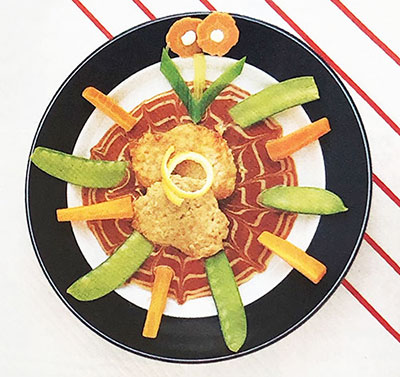|

Café de France
The French Cafe in Omaha, Nebraska was an
epicurean paradise of haute cuisine from 1969 to 2012. In 1976, the
restaurant's 34-year-old chef gave a cooking demonstration at
Omaha's Central High, chronicled in the school newspaper.
Marcel Keraval has
that friendly aura about him that is as distinctive as the scent
of fresh baked bread. His dark black hair complements his French
features. As a unique trademark, his smile is immortal.
When attempting to speak English
fluently, he sometimes allows a French term to replace a
forgotten English word in his rolling sentences. However, he is
recognized as a "showman" in his field.
Marcel, a chef at The French Cafe,
demonstrated his skills in the art of the French cuisine
recently at Central for a French II class and a home economics
class. Because
he was born in Brittany, a section of western France near the
sea, he prepared a dish which originated from that area, seafood
crepes. In a
heavy French accent, Marcel admitted, "Being a chef is a job you
have to like in order to be successful. You must constantly be
ready to prepare and serve lunch and dinner."
Central High Register, Mar 10,
1976
 |
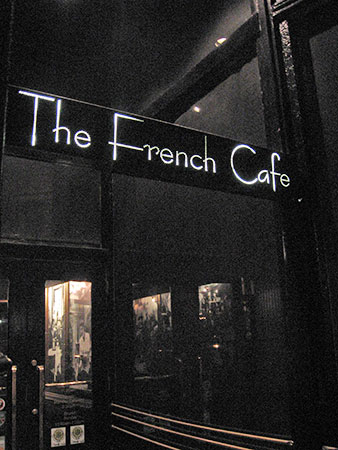 |
Marcel
Keraval
Central High Register, Mar 10, 1976 |
The
French Cafe
Omaha, Nebraska |
Marcel Keraval was born on May 31, 1941 in
Quimper, a small city in Brittany, on the west coast of France.
My granduncle was a
chef and from the time I was 10 years old, I knew I wanted to be
a chef, too. In
France, there are no high schools, like here. Kids go to
technical school. So from age 15, I was trained to be a chef.
And I never tried anything else, except when I was drafted into
the army . . . and I did not cook there.
Keraval attended the Culinary School of Tours
in the Loire Valley. After passing a rigid examination by the finest
chefs in Tours – "I cooked and they tasted" – he worked in restaurants in Paris, Lausanne and Basel,
before coming to New York in 1969.
I was in the Bahamas
at the time and wanted to get to the USA. I worked for three
years at Rockefeller Center, at The Rainbow Room.
It was in New York that Keraval became friends
with Jean-Claude Guillossou, who was a chef at Sign of the Dove on
Third Avenue. It was also in New York that Keraval met Monique
Lavoie, a French Canadian whose sister Rachel was married to Guillossou.
Marcel and
Jean-Claude were friends. You know they lived only 60 miles
apart in Brittany, but only met each other in the States. I will
always remember the day, because it was in 1969 when the first
man walked on the moon. Rachel and I walked into the apartment
and the men were watching all of this on television. We were
married in New York at a French church, St. Vincent de Paul,
during a big snowstorm!
The next stop for both the Keravals and the
Guillossous was The French Cafe in Omaha. Both Marcel and
Jean-Claude were recruited by the restaurant as chefs, but the
Guillossous' stay was short lived. They moved to St. Louis in 1972.
And not long after Marcel's cooking demonstration at Omaha's Central
High, he and Monique followed.
It was 1976. My
brother-in-law, Jean Claude, was chef at Westwood Country Club.
We decided to become partners and open L'Auberge Bretonne.
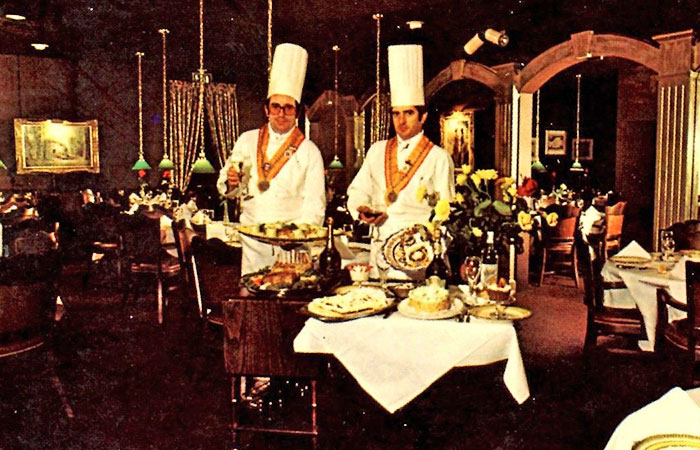 |
Jean-Claude Guillossou and Marcel Keraval
L'Auberge Bretonne, circa 1977 |
L'Auberge Bretonne was advertised as "the only
French restaurant with two executive chefs." Located at the corner
of Olive and Woods Mill in Chesterfield, it was soon recognized as
one of the best French restaurants in the area.
Although the West County restaurant flourished,
the brother-in-law chefs wanted a venue closer to downtown. So three
years later, in December of 1979, while Jean-Claude and Rachel
stayed behind to run L'Auberge, Marcel and Monique opened a second
restaurant at 410 Olive Street, on the ground floor of the Merchants
Laclede Building.
After three years, we
took over a place called Chez Jean Pierre – a good chef, yes,
but too high-priced. We called our place Café
de France.
The atmosphere at Cafe de France was simple but
elegant. Upon entering the restaurant, a tiny bar was located to the
right. Beyond that was a small dining room used for private events
and overflow.
The main dining room had a double-high ceiling
with two large crystal chandeliers overhead. Subdued floral wall
paper and gold-framed paintings formed a quiet background for tables
covered with heavily starched linen, extra-heavy silverware and
crystal wine glasses. Blue wainscoting and doors matched fabric in
the armchairs.
 |
Café de France's Main Dining Room
|
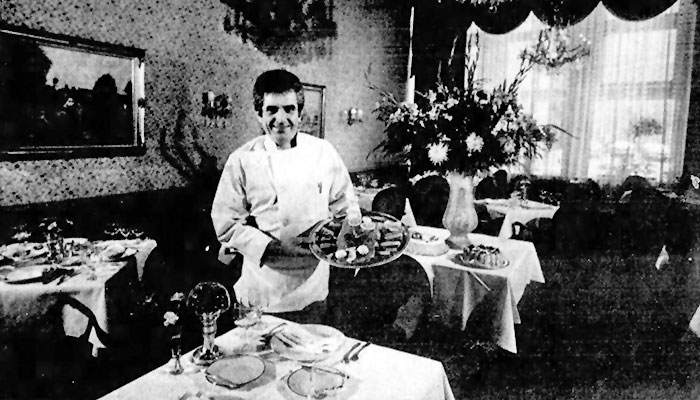 |
Marcel
Keraval in Café de France's Main Dining Room
St. Louis Post-Dispatch, July 4, 1984 |
Monique Keraval greeted diners with a "bon
jour" or "bon soir" in the small reception area. She was "the boss," according to her
husband Marcel.
She is maître d' and
bartender. She answers the phone and takes the cash. She can do
anything. When
we met, Monique did not cook. She didn't burn water, but she
didn't cook either. Now she is my official taste tester, food
advisor . . . it is her I look to.
We are together 24 hours a day and
miss each other when the other one isn't right there. We don't
fight, but talk and work out our disagreements. When the last
table is seated, we dine together in the small dining room,
something light, wine of course, we relax.
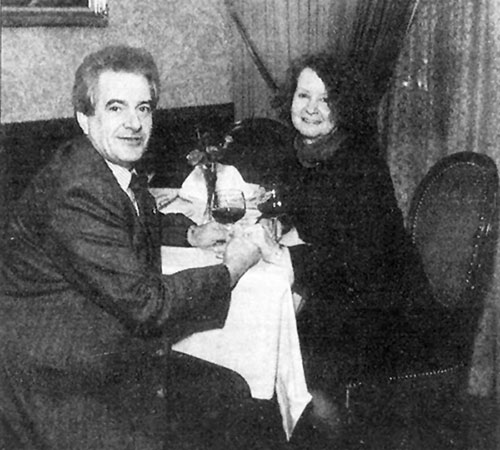 |
Marcel
and Monique Keraval
St. Louis Post-Dispatch, Mar 15, 1995 |
Although Café de France was basically a classic
French restaurant, Keraval heartily embraced the ideals of the
nouvelle cuisine movement and often applied French techniques to
American foodstuffs for a new approach.
I do my own cooking,
my own idea of French cuisine. Some dishes are very traditional,
very classic, but sometimes there is some nouvelle influence.
His generation of
chefs in France was the first to question their classical teachers.
We asked our
teachers, "Why should we cook the same things the same way they
did 50 or 100 years ago?" If painters worked like this you could
never tell a Renoir from a Gauguin. Cooking is the same way.
 |
 |
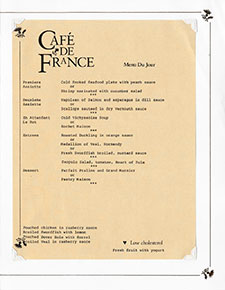 |
1984 Café de France Menu
(click image to enlarge) |
In June of 1985,
Café de France began offering special menus featuring the cuisine
from various regions of France. Jerry Berger announced the first in
his June 4, 1985 St. Louis Post-Dispatch column.
Welcome to our town,
Jean Claude DeMay, director-of tourism for the French province
of Normandy. DeMay was cornered the other night at Cafe de
France, where he helped to launch a two-week menu featuring the
cuisine of Normandy (at dinner and lunch), beginning Monday.
Cafe owners Monique and Marcel Keraval described some of the
fare (with bountiful hints of calvados – apple brandy –
indigenous to Normandy) and said they hoped to offer gourmet
menus of Brittany and Burgundy later on.
 |
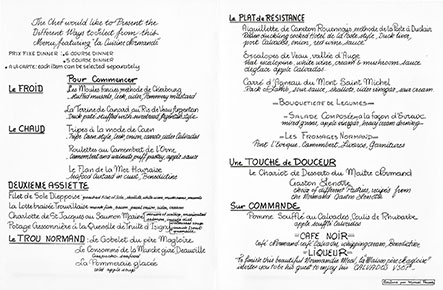 |
June 1985 Café de France
Menu
(click image to enlarge) |
Marcel Keraval likened his trade to the art of
painting. The plates were his canvas, the sauces were his medium,
the food his subject for an edible still life.
One of his most popular soups was the fresh seafood
seasoned with saffron. It arrived crowned with a puff pastry "lid." Keraval's trademark
was another stylish touch; he presented food with
two-color swirls of sauces. Entrees arrived with vegetable or meat
sauces in pools around the dish. Desserts were ringed with intensely
flavored fruit sauces.
 |
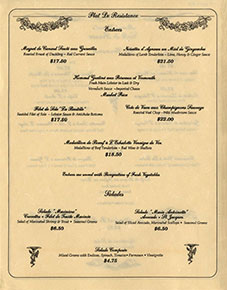 |
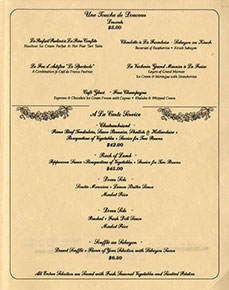 |
Winter 1988/1989 Café de
France Menu
(click image to enlarge) |
A decade after Café de France had opened,
tastes and attitudes towards food were changing, and Marcel
Keraval's menus changed with them.
Less butter, less
cream . . . today we say to feed the customer, not kill them.
Make it flavorful, but light. Customers do not want to leave a
restaurant feeling stuffed and uncomfortable. We want to make
them feel good! Years ago, in France, there was a famous colonel
who would go into a restaurant’s kitchen and if the chef was not
fat, he would assume the food not good and not eat there.
In December of 1989,
to celebrate Café de France's tenth anniversary, Keraval designed a
menu featuring his "finest specializes of the decade." His customers
likely left the celebration "feeling stuffed and uncomfortable."
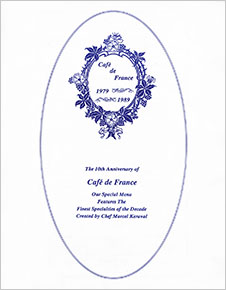 |
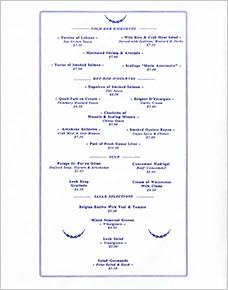 |
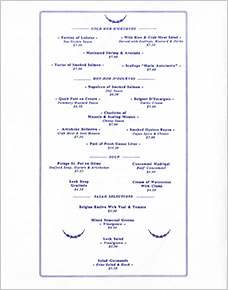 |
Café de France 10th
Anniversary Menu
(click image to enlarge) |
* *
* * *
In May 0f 2001, Charles Drury announced he had
purchased the 110-year-old Merchants Laclede Building and intended
to renovate it. At the time, the historic building was empty except
for one tenant – Café de France.
The building was to become a Hilton hotel with
a restored ornate lobby. Marcel and Monique Keraval's restaurant
would be rebuilt bigger and better.
We thought this would
be a nice thing for us. Drury said he wanted to demolish the
restaurant and redo the whole thing . . . and that it would
reopen at the end of October.
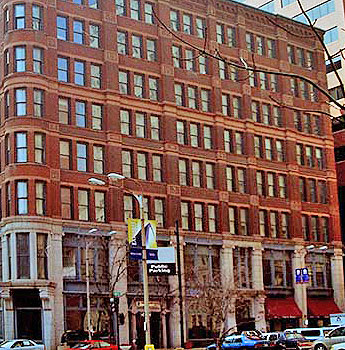 |
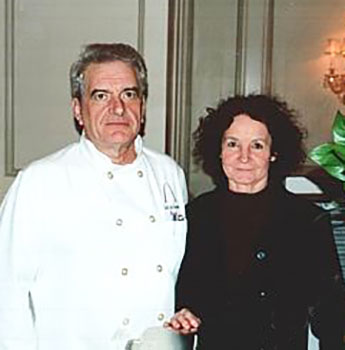 |
Merchants Laclede Building, March 2001
(Café de France, red awnings lower right) |
Marcel and Monique Keraval
October 2001 |
The Keravals closed their restaurant in
mid-August so demolition could proceed in the otherwise-empty
building. They put the restaurant's furniture into storage and
temporarily dismissed their 16 workers.
But after September 11, things changed. Drury
said his plans for the building had "slowed down" because of the
sagging economy. He told Keraval he didn't expect renovation to
resume at full speed until the following year at the earliest.
The restaurant's gone
. . . destroyed, and we had expected that to be our retirement.
And now I have to go look for a job, or try to find a small
restaurant to buy . . . and get back on my feet.
The Keravals did find a small restaurant to
buy. In June of 2002, Café de France moved into a space at 7515 Forsyth Boulevard
in Clayton that had formerly
housed Fio’s La Fourchette and, before that, The Leather Bottle.
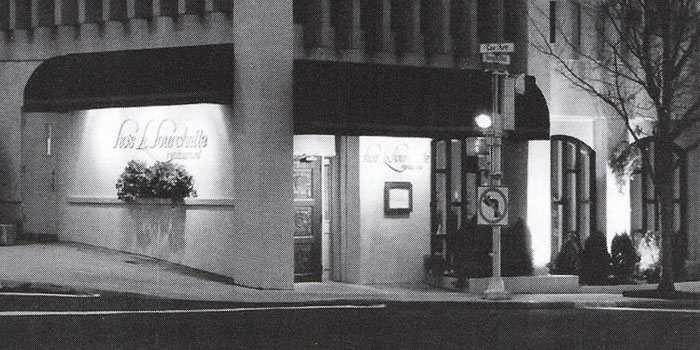 |
|
Fio’s La Fourchette, 7515 Forsyth |
Café de France's move went relatively well.
Although the unexpected duration of their furlough caused waiters
from the downtown location to find other work, most jumped at the
chance to rejoin Keraval in Clayton.
And according to Joe Bonwich in his August 1,
2002 St. Louis Post-Dispatch review, the local emperor of
haute cuisine had emerged from his exile.
Old classic-French
standbys like Dover sole, Chateaubriand and rack of lamb remain
on the menu (or among the specials) and soufflés account for
more than half of the desserts served, but menu items just as
frequently incorporate non-Gallic influences like nori, tabouleh
and jasmine tea. Whether the preparation was straight up or with
a twist, many of the dishes we tried left us with a strong urge
to dance on the table.
But the Keravals never seemed to hit a good stride in Clayton.
In 2003, Marcel Keraval suffered a stroke. While he completely
recovered, in September of 2006, Café de France closed for good.
Two months after we
opened in Clayton, [French president Jacques] Chirac went
against the war in Iraq, and all at once, people here became
anti-French. That was a tough time. But we survived for five
years.
 |
|
Monique and Marcel Keraval, 2003 |
Marcel Keraval had intended to retire after
closing Café de France. But he felt the urge to get back to doing
what he loved.
It gets in your
blood. And stays there. Chefs have to keep moving. They get
crazy if they don’t. Or they need a serious hobby!
I thought that the routine of doing
something like banquets would be good for me . . . so I went to
work at The Chase hotel.
And then, in 2010, Leon Bierbaum called looking
for a chef for his restaurant Chez Leon, which had relocated to
Clayton.
Leon called me
several times. First I thought no, then maybe, but I feel good,
so I thought, "Why not?" I was lucky with that stroke . . .
To me, it was a sign to keep cooking. So I do. I just don’t want
to fall into my sauce!
 |
|
Marcel and Monique Keraval with Leon
Bierbaum, 2011 |
In May of 2012, Chez Leon
abruptly closed and, at the age of 71, Marcel Keraval decided it
was finally time to retire. But in a May 12, 2012 Sauce Magazine
interview, Keraval was still planning meals. His last one.
Start with some
caviar, foie gras . . . a little lobster, and who knows
after that? A nice cheese with fruit and a beautiful
chocolate soufflé, sabayon, something like that. And some
good wine, a good vintage Bordeaux. Oh, some Champagne
probably with the caviar. After that I would so say,
"Bye-bye, all of you. Au revoir."
Copyright © 2020
LostTables.com
Lost TablesTM
is a trademark of LostTables.com. All rights reserved. |













